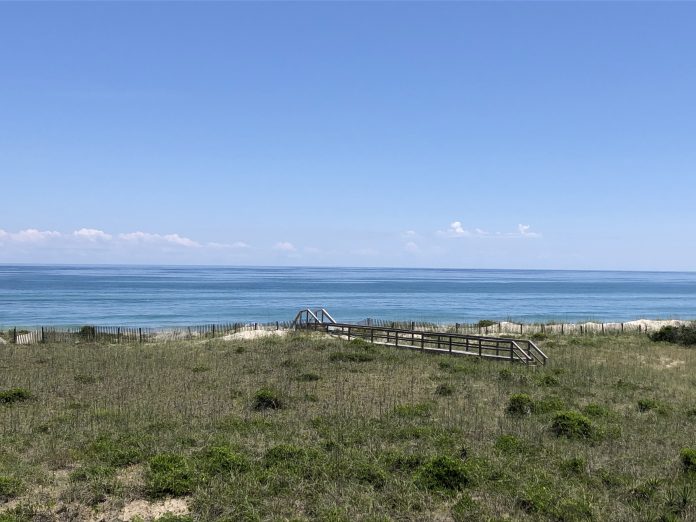
For over 20 years, my husband’s family has taken the same trip to the Outer Banks of North Carolina. We joined them for the tail end of our honeymoon and didn’t see the sun for three days. The sky was gray and it rained buckets during our entire time on the island. I didn’t understand their fascination with the barrier islands.
It wasn’t until I experienced it through the eyes of a child that I understood. We took our oldest daughter there for the first time the summer she turned 2. She was a beach baby the instant her feet hit the sand.
Everything excited her that first trip from trying to outrun the crashing waves to spotting ghost crabs at night scuttling across the sand. It became a tradition that our summers begin with a family road trip to the beach.
Eleven cousins who are usually scattered across Ohio and Michigan get to stay together in one beach house with their parents and grandparents. Beach days start out with apple uglies, a local pastry, and end with stargazing, a beach fire or playing cards late into the night.
We have always stayed far south of Nag’s Head, preferring the smaller towns along Highway 12. Undeveloped land of the Cape Hatteras National Seashore stretches out for miles along the coast.
Frisco, North Carolina
In most recent years, we have thoroughly enjoyed staying in Frisco, North Carolina. The island narrows down to a strip of land just barely wider than Highway 12. From the front porch on the beach house, we can see the sunset on the peaceful waters of the Pamlico Sound. A row of dunes sits in between the back of the beach house and the Atlantic Ocean.
Walking toward the beach is a trifecta of sensory appeal. Ocean waves can be heard crashing in the distance, a breeze swirls around the dunes, and the sweet aroma of dune flora lingers in the air.
Dunes moving west
Much to the dismay of locals and visitors alike, the sand and dunes of the Outer Banks are slowly moving west.
The string of barrier islands is not anchored by a coral reef. Since the early 1900s, efforts have been made to slow the shifting of the land. As a part of the New Deal in the 1930s, Work Progress Administration and Civil Conservation Corps workers reinforced the dunes by adding fences and planting grasses. Beach grass, sea oats, cordgrass and wiregrass were planted along with shrubs to strengthen the dunes.
At the very edge of the dunes, where the sand meets the grass, sea oats protect and stabilize the dunes in two ways. An extensive root system acts as an anchor stretching 10 meters below the surface of the sand to reach water. Grass leaves on the plants catch sand and prevent it from blowing away.
Fishing
In the muted morning sunshine, I took the path across the dunes for a walk along the shore. The boys woke up early to try saltwater fishing. I was impressed with their ability to seek advice and wisdom on fishing techniques.
Using the internet and asking questions at local bait shops, they learned about the right bait, lures and techniques. Spanish mackerel were their most frequently caught fish. The mackerel could be seen jumping and flipping out of the water.
My youngest son had his first ocean catch, a medium-sized whiting. Late one evening, my husband thought he caught a giant fish but instead had snagged a bluntnose stingray.
The Pamlico sound was another fishing opportunity. My oldest son was thrilled when he caught a large red drum. My husband was pleased with his luck catching speckled sea trout.
Fishing wasn’t the only thing spectacular on the soundside. The calm waters were perfect for kayaking and searching for hermit crabs. After days of playing lifeguard and keeping track of kids swimming in the ocean, the soundside felt much more relaxing to me.
We can count on one thing every year, the week goes by in the wink of an eye. Before we know it, it’s time to shake out the sand and pack up the cars.
We left the Outer Banks with more freckles and many new memories. The countdown to next year began as soon as we crossed the Wright Memorial Bridge onto the mainland of North Carolina.












